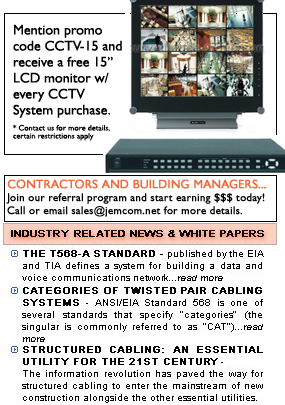

Categories of twisted pair cabling systems:
Typical UTP cable has four pairs of wires in each cable. Not all four pairs are used in actual applications. For most LANs, only two pairs are used, one in each direction to allow full duplex, simultaneous bidirectional communications. Due to the limitation on bandwidth and emission of radiation that could potentially affect other electronic devices, the higher speed networks are migrating toward using all four pairs.
The "quality" of the cabling systems to carry high frequency signals is expressed with the following marking:
-
Cat 1: Cabling that meets the minimum requirements for analog voice or Plain Old Telephone Service (POTS). Also known with name Grade 1. Commonly called inside wire by the Telco community. (Informal designation)
-
Cat 2: This is a 100 ohm UTP system capable of operating 1 Mbps Token Ring and similar networks. This is also known as IBM Type 3 cabling system. Also known with name Grade 2. (Informal designation)
-
Cat 3: This cable type is characterized to 16 MHz and supports applications up to 10 Mbps. Applications may range from voice to 10BASE-T. This is a low performance cable rating which is disappearing. This is the minimal requirement for good quality structured telephone cabling system. This is also known as ISO/IEC 11801 Class C cabling. This was the standard for UTP performance as late as 1988. The FCC recently changed the requirement for telephone inside wiring to minimum of Cat 3 due to crosstalk problems with non-twisted quad-four. CAT 3 is no longer recognized by TIA.
-
Cat 4: This cable type is characterized to 20 MHz and supports applications up to 16 Mbps. Applications may range from voice to 10BASE-T and 16 Mbps Token Ring.
-
Cat 5: The traditional rating of cables for high speed data installation. Rated frequency is 100 MHz. This cable works well from voice to 100BASE-T Ethetnet and 155Mbps ATM. This cable type is also known as ISO/IEC 11801 Class D cabling. Today Cat 5 copper communications wiring is the recognized minimum for broadband services. CAT5 performance is only possible when cable, connector modules, patch cords, and all electronics carry the same CAT5 rating.
-
Cat 5e: New rating developed in USA. Rated frequency is 100 MHz. Cat 5E is becoming the new standard for premises wiring, because it is recommended as the minimum for all future installations by TIA/EIA, IEEE and many equipment manufacturers. Enhanced Category 5, was ratified in 1999.
-
Cat 6: A new rating developed in the US. Rated frequency is 200 MHz with some requirements specified for 250 MHz. Category 6 is being specified concurrently by both ISO in the 11801-2001 document and the TIA in its Category 6 addendum to TIA 568B (ANSI/TIA/EIA-568-B.2-1 ratified by the TIA/EIA in June 2002). This presents the best performance possible with the current T568A and T568B wiring configurations on an 8 position 8 conductor modular connector (RJ-45).
-
Cat 7: A rating for individual pair screened cables derived from the german DIN 44312-2 standard requirements. Rated frequency is 600 MHz. The work is on progress. This is also known as ISO/IEC 11801 Class E. This cable is fully shielded and uses non-standard RJ-45 interface (Alcatel hybrid RJ-45 connector). This cabling is primarily for the European market place. Other alternative connector style is IBM Mini-C connector. In Europe this is known as Class F cabling.
For installation to meet specific Category requirements all components must meet or exceed the designated Category. Using a Cat 3 receptacle (or patch cord) on Cat 6 reduces performance to Cat 3.

HOME | SERVICES | CONSULT REQUEST | SUPPORT | CONTACT | PARTNERS | WHITE PAPERS
JEMcom Communications
Corp.
A division of J&E Graphic
© 2005 All rights
reserved